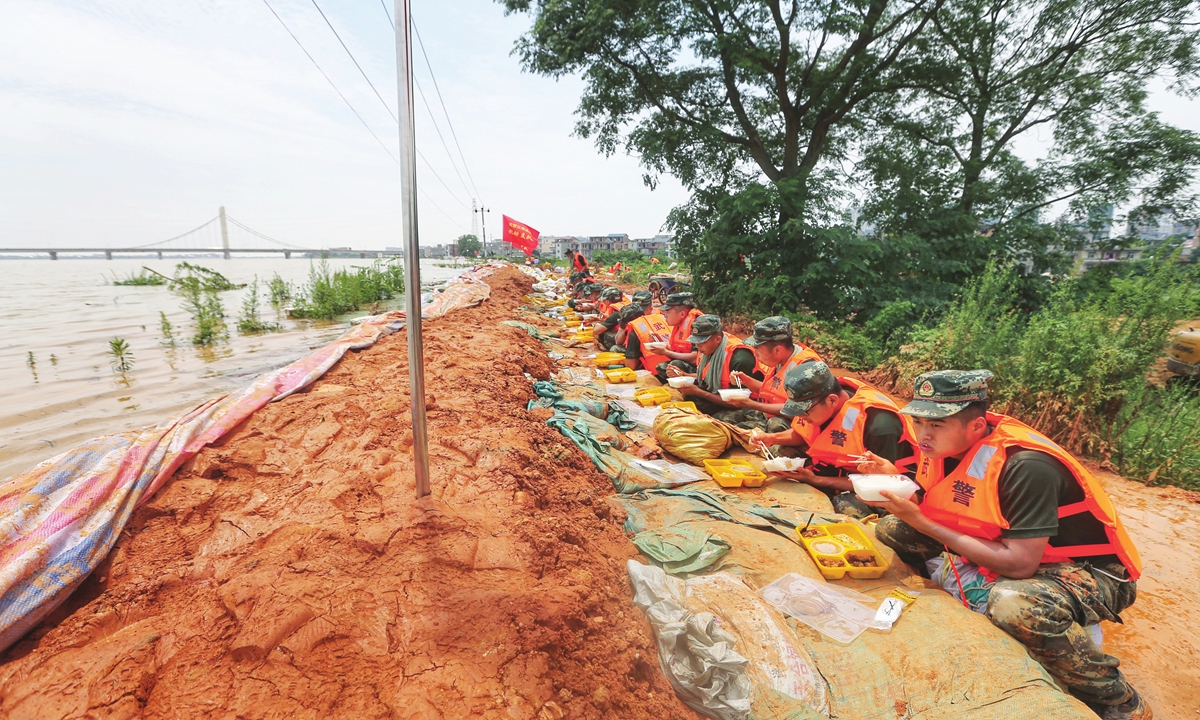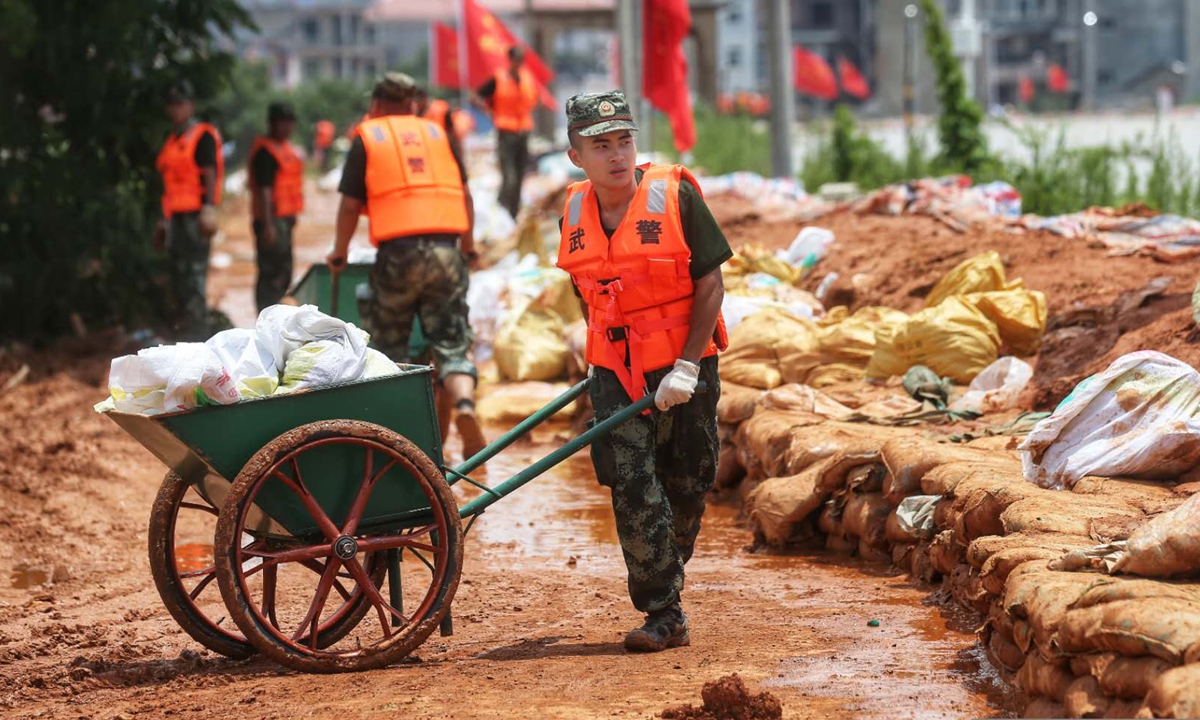A repeat of 1998 floods ‘unlikely to happen’
By Cui Meng in Poyang, Zhang Han and Xu Keyue in Beijing Source: Global Times Published: 2020/7/13 21:43:40

Armed police soldiers stick to the dyke while eating lunch on Monday. They battled the floods by reinforcing the river banks of Poyang Lake in East China's Jiangxi Province. The lake, China's largest freshwater lake, exceeded the highest-ever recorded water level on Sunday. Photo: Cui Meng/GT
Chinese People's Armed Police and People's Liberation Army soldiers are making their ways to the flood-hit areas to reinforce river banks and battle floods, as 433 rivers in the country, especially those along the middle and lower reaches of the Yangtze River, have floods exceeding the warning levels as of Monday.
Facing the potential catastrophe, some Western media outlets speculated that China will have a repeat of the 1998 floods despite a heavy investment in its water conservation system.
However, Chinese analysts dismissed such concerns, saying that while the situation might be still tough for the coming week or weeks, even probably the coming month, with the country's water conservation projects, especially the Three Gorges Project, enhanced emergency response mechanism, high technologies and Chinese people's determination and confidence, casualties and losses will be fewer, and the 1998 scenario will not be repeated.
Rush to dykes
The Ministry of Water Resources said at a press briefing Monday morning that 109 rivers have exceeded safe water levels, and 33 rivers have recorded their highest levels in history.
Exceeding the safety line means the water could overflow. In such a situation, the highest response level will have to be activated, and personnel will have to be stationed around the clock; dykes will be consolidated and heightened, and residents evacuated.
The ministry said the flood situation along the mainstream of the Yangtze, including major cities like Wuhan, is stable.
But the situation in East China's Jiangxi is among the most severe. Hydrological stations at Poyang Lake, the main water body in Jiangxi and the largest freshwater lake in China, have all exceeded warning levels, and at least four of the hydrological stations have exceeded the record flood levels of 1998.
Poyang Lake has reached its largest in areas in the past decade to 4,206 square kilometers, 20 percent bigger than the season's average.
At Wenguidao enclosure in Poyang township, emergency construction is underway to fix a breach at the dykes, with 300 construction personnel, 25 construction machines and 150 vehicles in use, Zeng Mingyang, an engineer at the frontline, told the Global Times on Monday.
Floodwaters from the lake overflowed into Wenguidao enclosure on Wednesday, inundating 62 square kilometers of farmland and six villages. More than 10,000 villagers were evacuated.
The 127-meter breach was closed on Monday night, earlier than previously estimated, Zeng said.
"We have two 12-hour shifts around the clock. Application of GPS and water velocimeter can help us throw the stones at the right time to prevent them from being washed away by the floodwaters," Zeng said.
At Xihe River in Poyang county, PLA Rocket Forces soldiers piled sand bags to fortify dykes at an enclosure where soil piping occurred. If these weak points were not fixed, the dykes could collapse at any moment, putting 10,000 villagers in danger, and destroying 202 square kilometers of farmland.
Water from the Changjiang River, a tributary flowing into Poyang Lake, has exceeded the dyke and is rising closer to the height of an urgently built "mud great wall." If it overflows, the Poyang county center three kilometers away will be under threat.
Some 500 People's Armed Police soldiers from the Jiangxi headquarters rushed to Changjiang overnight to protect the dykes.
Most villagers have been evacuated, and some young men stayed behind to carry out logistics work. They sent food and water to frontline soldiers, and some also helped transport and pile sandbags on the dykes.
Xia Shiwei, who is working at the Changjiang bank, told the Global Times on Monday that the water level receded a little bit, but heavy rain is expected starting tomorrow, which may raise the water level by 2-3 centimeters.
Most elderly people in two villages Xia took charge of have been evacuated, but some refused to leave their homes. Xia and his colleagues are trying to convince them to move to temporary care centers on high ground.
Wang Zhonghua, a Poyang county official, is at the frontline with a few hundred armed police soldiers, urban management veterans, officials and volunteer villagers on Monday. Wang told the Global Times that many people, including himself, suffered from sunstroke. The local temperature on Monday was 33 C, with 84 percent humidity on Monday.
"We will stay with the dyke till the end," Wang said.

A soldier carries a sandbag at the Changjiangyu dam Photos: Cui Meng/GT
A test of overall capability
Analysts warned that the breach of dykes and inundation in the Poyang Lake basin also exposed the weak links in China's flood control work.
As the monsoon is expected to bring more rain to the Yangtze basin in late July and early August, floods will test China's water conservation engineering system that has gone through major reforms in the past 22 years after the 1998 catastrophe.
China, with its monsoon climate, has always been struggling with floods and droughts, and water conservation is at the center of social management throughout history.
This year, the deluge in many areas is heavier than that of 1998, and floodwaters have exceeded the marks for that year. But casualties will be fewer, thanks to the water conservation system and emergency response mechanism, analysts said. According to these analysts, the Three Gorges Project and other smaller water projects can play an important role in adjusting flood peaks of the basins.
But analysts noted these projects can only minimize the impact of floods rather than avoid them completely, as unfavorable weather, like this year's longer monsoon rain across the Yangtze basin, could generate results beyond the capability of human projects.
Gao Jianguo, a member of the National Disaster Reduction Committee under the Ministry of Emergency Management, told the Global Times on Monday that after the disastrous 1998 floods, Chinese cities have raised flood prevention levels, building higher dykes and setting up overflow zones that are usually in form of riverbank parks. These arrangements guarantee that major cities like Wuhan in Central China's Hubei Province and Jiujiang in Jiangxi, will be protected from historic floods, Gao said.
Investment also went to consolidating steel and concrete dykes, mainly in cities, and high-tech detectors can help discover weak points inside, he said.
Analysts said the recent floods, most acute in Jiangxi, also demonstrated the necessity to push forward the "return farmland to lake" project, which was initiated after the 1998 floods.
It is almost impossible to avoid a breach if a rural mud dyke is soaked in water for weeks, like what is happening in Jiangxi, Gao said. The key to flood control in these areas is to build outflow enclosures without residents. Such enclosures could be farmlands in most years, but can be inundated to hold water in years of major floods to protect residential areas, Gao noted.
Major floods of this year's scale are a test of not only the country's water conservation system but also its overall capabilities in tackling disasters.
"We are still filling in the question sheet, and scores will be clear when rainy season passes," Gao said.

Infographic: GT
Newspaper headline: Flood alarm at 433 rivers
Posted in: SOCIETY